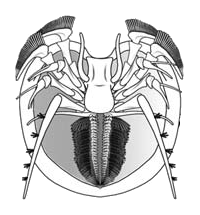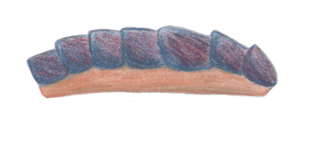Traditionally, the Myodocopa and Podocopa have been classified as subclasses within the class Ostracoda, although there is some question about how closely related the two groups actually are. The Myodocopa are defined by possession of a poorly calcified carapace, and 8–9 articles in the exopod of the second antenna. The ventral margin of the carapace is not concave, and the valves do not overlap to a great extent.

The Signor–Lipps effect is a paleontological principle proposed by Philip W. Signor and Jere H. Lipps which states that, since the fossil record of organisms is never complete, neither the first nor the last organism in a given taxon will be recorded as a fossil. The Signor–Lipps effect is often applied specifically to cases of the youngest known fossils of a taxon failing to represent the last appearance of an organism. The inverse, regarding the oldest known fossils failing to represent the first appearance of a taxon, is alternatively called the Jaanusson effect after researcher Valdar Jaanusson, or the Sppil–Rongis effect.
The Silurian Lagerstätte preserved in the limestone Wenlock Series of Herefordshire, England, offers paleontologists a rare snapshot of a moment in time, about 420 Mya. In the formation, layers of fine-grained volcanic ash punctuate a sequence of carbonate muds that were accumulating in a marine environment on the outer continental shelf. In this fine-grained matrix, soft-bodied animals and delicate, lightly sclerotized chitinous shells are often preserved in three dimensions, as calcitic fossilizations within calcareous nodules. Calcitic fossilization is an unusual feature.

Megacheira is an extinct class of predatory arthropods that possessed a pair of great appendages, hence the class name as well as the common name "great appendage arthropods". Their neural structures and deutocerebral appendages resemble those of chelicerates. Most of them were found in marine environments throughout the world from the lower to middle Cambrian. Megacheirans were important components of several faunas, including the Burgess, Wheeler and Maotianshan Shales Lagerstatten.
Heloplax is a genus of worm-like molluscs. Its soft parts are preserved in three dimensions in the Silurian Herefordshire lagerstatte; its disarticulated valves are known from other Silurian deposits. It is very bizarre by modern standards; it bears serially repeated units, and has spines. It probably falls somewhere between the aplacophorans and polyplacophora; its valves were composed of aragonite
Acaenoplax is an extinct worm-shaped mollusc known from the Wenlock Series lagerstätte of Herefordshire, England. It lived in the Silurian period. It was a couple of centimetres long and half a centimetre wide, and comprises serially repeated units with seven or eight shells, and rings of 'spines'.

Platyceratidae is an extinct family of Paleozoic sea snails, marine gastropod mollusks. This family may belong in the Patellogastropoda or the Neritimorpha.

Synziphosurina is a paraphyletic group of chelicerate arthropods previously thought to be basal horseshoe crabs (Xiphosura). It was later identified as a grade compose of various basal euchelicerates, eventually excluded form the monophyletic Xiphosura sensu stricto and only regarded as horseshoe crabs under a broader sense. Synziphosurines survived at least since early Ordovician to early Carboniferous in ages, with most species are known from the in-between Silurian strata.
Cinerocaris is an extinct genus of crustaceans which existed in the United Kingdom. It contains the species Cinerocaris magnifica.
Nasunaris flata is an extinct genus of ostracods which existed in the United Kingdom during the Silurian period. It was first named by David J. Siveter, Derek E. G. Briggs, Derek J. Siveter and Mark D. Sutton in 2010.

Xylokorys is a genus of marrellomorph known from two specimens from the Silurian Herefordshire lagerstatte; it filter-fed on mud particles on the sea floor. It is the only marrellomorph known from the Silurian period.

Kulindroplax perissokomos is a Silurian mollusk, known from a single fossil from the Wenlock Series Lagerstätte fauna of England. It lived during the Homerian Age. It is considered a basal aplacophoran. Unlike all modern aplacophorans, which are shell-less, Kulindroplax has a chiton-like shell, and it is considered a transitional fossil in the evolution of molluscs.
Phthipodochiton is an extinct genus of molluscs, known from several fossils from the upper Ordovician fauna of the Lady Burn Starfish beds of Girvan, Scotland. It shows a mixture of aplacophoran body plan and polyplacophoran-like valves, and it is an informative fossil in the evolution of aculiferan mollusks.
Pauline is a fossil genus of ostracods from the Silurian. Genus contains two species: Pauline avibella found in 425-million-year-old rocks in the Herefordshire Lagerstätte in England near the Welsh Border and Pauline nivisis, known from the Lower Silurian Pentamerus Bjerge Formation of north Greenland.
Kenostrychus is a monospecific genus of polychaete worms known from exceptional 3D fossils from the Silurian Herefordshire lagerstatten.

Coronocephalus is an extinct genus of trilobites in the Phacopid family Encrinuridae. Species are from the Silurian of Australia and Japan, and from the Silurian and Ordovician of China.

Prosomapoda is a clade of euchelicerates including the groups Xiphosura and Planaterga, as well as several basal synziphosurid genera. The clade is defined by the lack of exopods of prosomal appendage II-V in the adult instar, where in contrast the exopods of appendage II-V are well-developed in the non-prosomapod euchelicerates Offacolus and Dibasterium.

Offacolus is an extinct genus of euchelicerate, a group of chelicerate arthropods. Its only species, O. kingi, has been found in deposits from the Silurian period in the Wenlock Series Lagerstätte of Herefordshire, England. It is the only member of the monotypic family Offacolidae, and classified as a basal ("primitive") genus in the clade Euchelicerata, along with Dibasterium and Prosomapoda. The genus is named after Offa, a king from the ancient kingdom of Mercia, and colus, a person who dwelled among the Offa's Dyke. The species name honors Robert Joseph King, a British mineralogist who found the fossils of Offacolus.
Sollasina is an extinct genus of ophiocistioid that flourished 430 million years ago. Its fossil remains have been recovered from the Wenlock Series of the Silurian Herefordshire Lagerstätte in England.

Dibasterium is an extinct genus of euchelicerate, a group of chelicerate arthropods. Fossils of the single and type species, D. durgae, have been discovered in deposits of the Middle Silurian period in Herefordshire, England. The name of the genus is derived from the Latin words dibamos and mysterium ("mystery"), meaning "mystery on two legs" and referring to its prosomal limbs. The species name durgae comes from Durga, a Hindu goddess with many arms.









